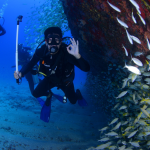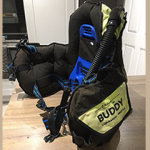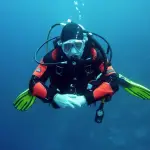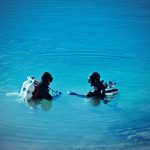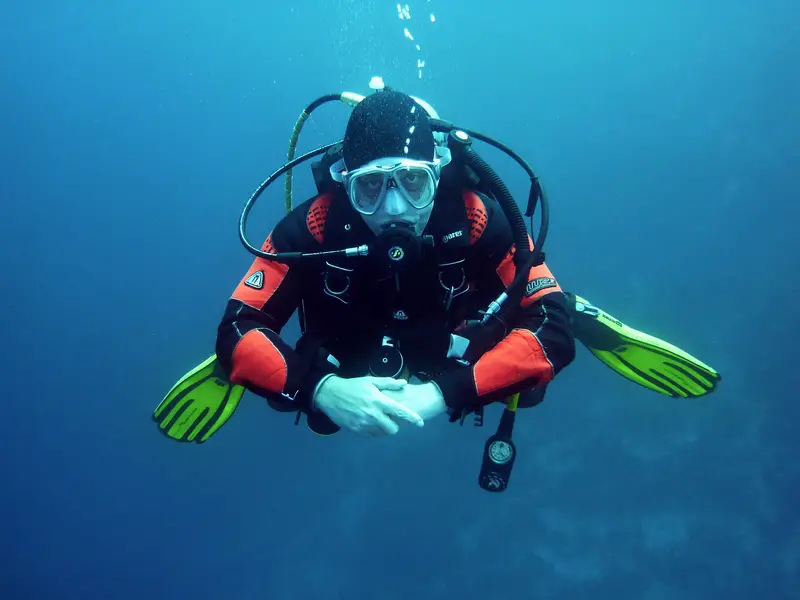
Improving buoyancy control is an important skill for activities such as scuba diving, snorkeling, and swimming.
The best way to improve buoyancy control is to use your buoyancy control device effectively, master your breathing and perfect your weights. Maintaining a better body position and fine tuning your finning technique also helps, but one of the best ways to improve buoyancy control is to dive more.
Here are some tips to help you enhance your buoyancy control:
- Master your breathing: Proper breathing techniques play a crucial role in buoyancy control. When you inhale, you become more buoyant, and when you exhale, you become less buoyant. Practice slow and controlled breathing, and use your breath to fine-tune your buoyancy as needed.
- Use your BCD (Buoyancy Control Device) effectively: Your BCD is a vital tool for buoyancy control while scuba diving. Learn how to operate it properly, including adjusting the amount of air inside to achieve neutral buoyancy. Practice inflating and deflating the BCD in small increments to find the right balance.
- Perfect your weight system: Ensure that you have the correct amount of weight for your body composition and equipment. Being overweighted can make it harder to maintain neutral buoyancy, while being underweighted can lead to excessive positive buoyancy. Experiment with different weight configurations to find what works best for you.
- Maintain proper body position: Body positioning greatly affects buoyancy. Keep your body streamlined, with your lungs slightly inflated and your legs elevated to minimise drag. This posture can help you achieve better control and reduce unnecessary exertion.
- Fine-tune your finning technique: Proper finning technique can contribute to better buoyancy control. Practice using slow, deliberate kicks to minimise disturbances to the water column. Avoid using your arms excessively, as it can disrupt your balance.
- Develop situational awareness: Pay attention to your surroundings and how they impact your buoyancy. Water currents, depth changes, and equipment adjustments can affect your buoyancy. Be mindful of these factors and make gradual adjustments as needed.
- Practice regularly: Buoyancy control is a skill that improves with practice. Spend time in the water regularly, whether it’s in a pool or open water, to familiarise yourself with your buoyancy characteristics and refine your control.
- Seek professional training: Consider taking a buoyancy control course or consulting with a dive professional. They can provide personalised guidance, offer tips specific to your diving style, and help you overcome any specific challenges you may be facing.
- Dive more: The more you dive, the better you will get at buoyancy control. One of the best ways to do more scuba diving is to book a dive liveaboard (see below).
Remember, improving buoyancy control takes time and experience. By incorporating these tips and dedicating yourself to practice, you’ll gradually enhance your skills and become more confident and comfortable in the water.
As I’ve already explained, and what I used to tell my diving students, is to book on a liveaboard diving boat as a way to enjoy diving and to get more diving experience. If you are please take a look at the following window:
Which is a way to increase buoyancy?
To increase buoyancy, you can take the following steps:
- Add or increase the amount of air in your BCD: Your Buoyancy Control Device (BCD) is designed to hold air, which affects your buoyancy. By inflating the BCD, you displace more water, resulting in increased buoyancy. Use the inflation button or oral inflator to add air to your BCD slowly and in controlled increments until you achieve the desired buoyancy level.
- Increase your lung volume: By taking a deep breath and filling your lungs with air, you can increase your buoyancy. This technique is particularly useful when snorkeling or swimming on the surface. Remember to exhale slowly and fully when you want to decrease your buoyancy. Also, avoid holding your breath too.
- Use buoyancy aids: Depending on the activity you’re engaged in, you can utilise buoyancy aids such as floatation devices, pool noodles, or buoyancy vests. These items provide additional buoyancy and help you stay afloat more easily.
- Wear a wetsuit or drysuit: Both wetsuits and drysuits are made of neoprene, which contains tiny air bubbles. These air bubbles provide inherent buoyancy, assisting in keeping you afloat. Wearing a wetsuit or drysuit can increase your overall buoyancy.
- Attach buoyancy devices: Some activities, like snorkelling, may involve attaching specific buoyancy devices to your body or equipment. These can include floats, buoyancy compensators, or lift bags. These devices are designed to add buoyancy when needed.
It’s important to note that while increasing buoyancy can be helpful in certain situations, it’s equally important to maintain control and achieve neutral buoyancy when necessary.
Buoyancy control is about finding the right balance for your specific activity and depth, so be mindful of the impact that increased buoyancy may have on your overall control and stability in the water.
What are the three A’s of buoyancy control?
The three A’s of buoyancy control, commonly referred to in scuba diving, are:
- Adjust: The first A stands for “Adjust.” It refers to making adjustments to your buoyancy to achieve neutral buoyancy, where you neither sink nor float. This is typically done by adding or releasing air from your buoyancy control device (BCD) or drysuit. By adding air, you become more buoyant and float towards the surface, while releasing air makes you less buoyant, causing you to sink. The goal is to find the right balance to maintain a stable position underwater.
- Attitude: The second A stands for “Attitude.” It emphasises maintaining the proper body position and trim in the water. By maintaining a horizontal position with a slight feet-downward angle, you can minimise drag and create a streamlined profile, which helps with buoyancy control. Proper attitude also ensures that you are not disturbing the environment or kicking up sediment, which can affect visibility and marine life.
- Awareness: The third A stands for “Awareness.” It involves being mindful of your buoyancy and keeping track of your depth and position in the water. By maintaining situational awareness, you can make necessary adjustments to your buoyancy control as you ascend, descend, or change your position in the water column. Being aware of your surroundings also helps you avoid contact with fragile marine life or damaging the underwater environment.
These three A’s—Adjust, Attitude, and Awareness—work together to help divers achieve precise buoyancy control, which is crucial for safety, conservation, and an enjoyable diving experience.
What two pieces of equipment do you use to control your buoyancy?
The two primary pieces of equipment used to control buoyancy in scuba diving are:
- Buoyancy Control Device (BCD): The BCD is a vest or jacket worn by divers that allows them to adjust their buoyancy underwater. It has an inflatable bladder that can be filled with air from a tank or released using an exhaust valve. By adding air to the BCD, the diver becomes more buoyant and rises in the water, while releasing air makes the diver less buoyant and allows for descent. The BCD also serves as a harness for attaching the tank and provides pockets or D-rings for carrying additional gear.
- Weights: In addition to the BCD, weights are used to offset the natural buoyancy of the diver’s body and equipment. The weight system can vary depending on the type of diving and individual needs. Divers wear weights, typically in the form of weight belts or integrated weight systems, to counterbalance the positive buoyancy of their bodies and equipment. The amount of weight required depends on factors such as body composition, exposure suit thickness, and the additional gear being carried.
By using the BCD and adjusting the amount of air inside it, along with the appropriate amount of weights, divers can achieve neutral buoyancy and maintain precise control of their position in the water column.
There is a third piece of equipment you use to control your buoyancy when diving in colder water, which is a drysuit. When I dive in my drysuit, I use the drysuit to control my buoyancy instead of my BCD. When diving in a drysuit you still need weights to achieve neutral buoyancy too.
How do you get neutral buoyancy?
Achieving neutral buoyancy, where you neither sink nor float but remain suspended at a particular depth, is a skill that scuba divers aim to master. To achieve neutral buoyancy, you need to find the right balance between the upward force (buoyancy) and the downward force (gravity) acting on your body and equipment.
Here are the steps to attain neutral buoyancy:
- Adjust your weights: Begin by ensuring that you have the appropriate amount of weights to offset your natural buoyancy. This may require some experimentation and adjustments. Start with a conservative amount of weight and add or remove weights as needed during the dive. Remember that the amount of weight required can vary based on factors such as your body composition, exposure suit thickness, and the equipment you are carrying.
- Descend and add air to your BCD: Start your descent by kicking gently or deflating your BCD slightly to allow yourself to sink. As you descend, add small bursts of air to your BCD to slow down or stop your descent when you are close to neutral buoyancy. Make small adjustments until you can achieve a state where you remain suspended in the water without sinking or floating upward.
- Fine-tune with breath control: Once you are close to neutral buoyancy, you can further fine-tune your position by utilising breath control. Taking a deep breath makes you more buoyant, while exhaling slightly or fully reduces your buoyancy. By controlling your breathing, you can make minor adjustments to maintain neutral buoyancy.
- Monitor and adjust as needed: Throughout the dive, continuously monitor your buoyancy and make adjustments as necessary. As you consume air from your tank, your buoyancy will change, requiring periodic adjustments. Additionally, changes in depth, body position, or the addition or removal of equipment may affect your buoyancy, so remain aware and make corresponding modifications to your BCD or weights.
Remember that achieving and maintaining neutral buoyancy takes practice and experience. It is essential to fine-tune your buoyancy control skills through training and regular diving to become more comfortable and proficient in achieving and maintaining neutral buoyancy in various conditions.
What does it mean to be negatively buoyant?
Being negatively buoyant means that an object or a person has a buoyancy force that is less than the gravitational force acting on it. In simpler terms, it means that the weight of the object or person is greater than the buoyant force exerted by the surrounding fluid (usually water), causing it to sink or descend.
In the context of scuba diving, being negatively buoyant underwater means that a diver’s overall weight, including their body, equipment, and weights, is greater than the upward force exerted by the surrounding water. This causes the diver to sink or descend towards the bottom unless corrective measures are taken.
Divers often aim to achieve neutral buoyancy, where the buoyant force equals the weight, allowing them to hover at a particular depth without sinking or floating. However, when a diver is negatively buoyant, they can control their descent by adjusting their buoyancy control device (BCD), using their breath control, or by adding or releasing weights.
Proper buoyancy control is essential for divers to maintain their desired depth, conserve energy, and interact safely and responsibly with the underwater environment.
It’s important to note that negative buoyancy is different from being positively buoyant, where the buoyant force exceeds the weight, causing the object or person to float or rise to the surface. Achieving and maintaining neutral buoyancy is a crucial skill for divers to master to ensure a safe and enjoyable diving experience.
At what depth do you become negatively buoyant?
The depth at which a diver becomes negatively buoyant depends on various factors, including the diver’s body composition, the equipment being used, and the type of exposure suit worn. In general, the depth at which a diver transitions from positive buoyancy to negative buoyancy varies.
Initially, when a diver enters the water, they are typically positively buoyant due to the air trapped in their exposure suit and BCD. As the diver descends, the water pressure increases, compressing the air in their suit and BCD. This compression reduces the volume of air, leading to a decrease in buoyancy.
The depth at which a diver becomes negatively buoyant is often referred to as the “crossover point.” It is the depth where the diver’s weight, including the weights they carry, exceeds the buoyant force provided by the compressed air in their suit and BCD.
The crossover point can vary widely based on individual factors. As an approximate guideline, many divers may experience negative buoyancy around 10 to 30 feet (3 to 9 meters) of depth. However, it is essential to note that this can vary significantly depending on factors such as the thickness and type of exposure suit, the amount of air in the BCD, and the weight configuration.
To maintain control and buoyancy during descent, divers often make use of their BCD and adjust the amount of air inside to achieve neutral buoyancy around their desired depth. Once they have reached the crossover point and become negatively buoyant, they rely on their weights and proper trim to control their descent and maintain a comfortable depth.
It is crucial for divers to have a good understanding of their own buoyancy characteristics and to practice buoyancy control techniques during training and experience to ensure safe and enjoyable dives at different depths.
Does cold water increase buoyancy?
Cold water can increase buoyancy compared to warm water. The reason for this lies in the physical properties of water and the effect of temperature on density.
When water is colder, it becomes denser. As the density of water increases, it provides more buoyant force to objects submerged in it. This means that a given volume of cold water will exert more upward force or buoyancy compared to an equivalent volume of warmer water.
The increase in buoyancy in cold water can have a few implications for divers:
- Increased buoyancy of equipment: Cold water can cause exposure suits, such as wetsuits or drysuits, to compress less, which leads to more air being trapped inside the suit. This trapped air increases buoyancy, making the diver feel more positively buoyant. Divers may need to adjust their weighting and BCD inflation to compensate for the increased buoyancy of their equipment.
- Increased buoyancy of gas in the tank: The air or gas inside a scuba tank is also affected by temperature changes. Cold water can cause the gas to compress less and occupy a larger volume, leading to increased buoyancy. Divers need to be aware of this effect and consider adjusting their buoyancy control accordingly, especially when making ascents or safety stops.
It’s important to note that the impact of water temperature on buoyancy is just one factor to consider in buoyancy control. Other factors, such as the diver’s body composition, equipment, and weight configuration, also play a significant role.
Divers should always be prepared to adjust their buoyancy control techniques based on the specific conditions they encounter during their dives, including water temperature.
Can people be negative buoyant?
People cannot be negatively buoyant in water. The human body is naturally buoyant, meaning that it tends to float in water rather than sink. This is primarily due to the composition of the human body, which consists of tissues and fluids that are less dense than water.
The human body has an overall density that is slightly less than that of water. This means that when a person enters water, they experience an upward buoyant force that counteracts the downward force of gravity. As a result, most people will naturally float or be positively buoyant in water without needing additional support or effort.
However, it’s important to note that the specific buoyancy characteristics of an individual can vary depending on factors such as body composition, lung volume, and the presence of air trapped in the body. For instance, a person with a higher percentage of body fat may experience greater buoyancy compared to a person with a higher muscle mass.
While people cannot be negatively buoyant, they can adjust their buoyancy underwater by wearing weight systems or adding weights to counteract their natural buoyancy. This allows divers to achieve neutral buoyancy, where they neither sink nor float, and maintain precise control of their position in the water column.
How can I increase my buoyancy naturally?
To increase your buoyancy naturally while in water, there are a few strategies you can consider:
- Taking a deep breath: Inhaling deeply and filling your lungs with air increases your buoyancy. The air trapped in your lungs creates additional buoyant force, helping you stay afloat more easily. However, keep in mind that relying solely on breath-holding for buoyancy control is not recommended during diving activities, as it can lead to potentially dangerous situations. It is crucial to maintain proper breathing techniques and follow appropriate scuba diving practices.
- Increasing body fat: Body composition plays a role in buoyancy. Body fat is less dense than water, so individuals with a higher percentage of body fat tend to be naturally more buoyant. However, this is not a recommended strategy to intentionally increase buoyancy, as it is important to prioritise overall health and fitness rather than altering body composition solely for buoyancy control.
- Wearing buoyant clothing or gear: Wearing buoyant items, such as inflatable vests or life jackets, can increase your natural buoyancy in water. These items provide additional floatation and help keep you afloat. However, it is important to choose appropriate gear for the activity you are engaging in and ensure that it does not interfere with your safety or mobility.
- Utilising buoyancy aids: Various types of buoyancy aids, such as kickboards or pool noodles, can be used to increase buoyancy naturally during recreational activities or swimming. These aids provide additional buoyant force, making it easier to stay afloat and maintain a more relaxed posture in the water.
Remember that while these strategies can enhance your buoyancy naturally, it is essential to prioritise safety, learn proper swimming techniques, and follow appropriate water safety guidelines when engaging in water-related activities.
I hope you enjoyed this article about how can I improve my buoyancy control
I’d love to hear from you. Tell us about your adventures of diving and snorkelling. Please use the comments section below. Please also share your photos. Either from your underwater cameras or videos from your waterproof go-pro’s!
If this article hasn’t answered all of your questions. If you have more questions either about snorkelling or scuba diving (or specifically about how can I improve my buoyancy control), please comment below with your questions.
There will also be many more articles about scuba and scuba diving safety tips (and on snorkelling too) for you to read and learn about this fabulous sport.
Have fun and be safe!

